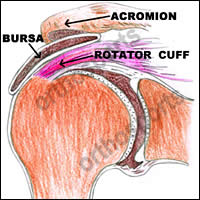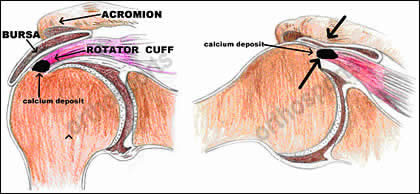What is Impingement, Bursitis and Tendonitis?
Impingement is the most common condition seen in the shoulder and is also known as “bursitis”. Shoulder impingement occurs when the top of the shoulder blade (acromion) puts pressure on the underlying soft tissues when the arm is lifted away from the body. As the arm is lifted, the acromion rubs, or “impinges” on, the rotator cuff tendons and bursa (the fluid filled sack which lubricates this area). This can lead to bursitis and tendonitis, causing pain and limiting movement.

People who use their arms overhead for sports such as tennis, swimming and throwing sports are particularly vulnerable. Also at risk are people who do repetitive lifting or overhead activities using the arm, such as painting, passing electrical cables or construction. It is also more common as one ages because the Rotator Cuff degenerates and is therefore more likely to become inflamed. The condition is also more common when the Acromion bone has a hook or spur, but it should be noted that up to 70% of people are born with a hooked Acromion, and the majority of people who have such hooks live without symptoms.

Sometimes a minor injury may be the cause of the pain. However, pain can occur with no apparent cause. During the day the shoulder might not hurt when the arm is by the side. It does hurt with overhead or sporting activities though. Symptoms of night pain and difficulty sleeping are common and often significant but why the pain in the shoulder is worse at night is unknown. Patients often complain of loss of motion and power. This condition can occur at any age and is usually completely reversible without an operation. Anti-inflammatory tablets, cortisone injections (which reduce inflammation and swelling and stop the tendon pinching as much) and physiotherapy are the mainstay of treatment. You will need to see a physiotherapist to learn some exercises and it is important to do the stretching and strengthening exercises two or three times a day by yourself. Ideally you should also avoid overhead activity and heavy work until the condition settles. It often takes 3 to 6 months for the symptoms to resolve.
Diagnosis
Impingement is a clinical diagnosis and the only imaging or test required is a plain X Ray. Ultrasound does not help with the diagnosis or treatment of this condition. About 10% of people continue to have symptoms despite excellent treatment. These people do need further investigations performed in the form of an MRI arthrogram (a Gadolinium dye is injected into the shoulder to make the test more accurate when looking for partial thickness rotator cuff tears). In the initial stages shoulder impingement and a frozen shoulder can be difficult to differentiate from each other. Both create stiffness and both can show some improvement with a subacromial corticosteroid injection. The “frozen shoulder” eventually ‘declares itself’ over a few months with severe pain at the ends of movements and shoulder stiffness with significant loss of range of motion.
Treatment
If non operative treatment does not work over 3 to 6 months and further investigations reveal that there is no other cause for the pain, then an Arthroscopic Acromioplasty may be recommended. This is a relatively small operation done through an arthroscope (keyhole / minimally invasive surgery) where the acromion bone is trimmed/filed down to allow more space for the Rotator Cuff to move. Surgery is not commonly required and is only offered if non operative treatment fails.
Remember:
- This condition is usually completely curable with non operative treatment
- Physiotherapy is very important
- Avoid overhead activity and heavy work until symptoms settle
- Surgery is rarely necessary


